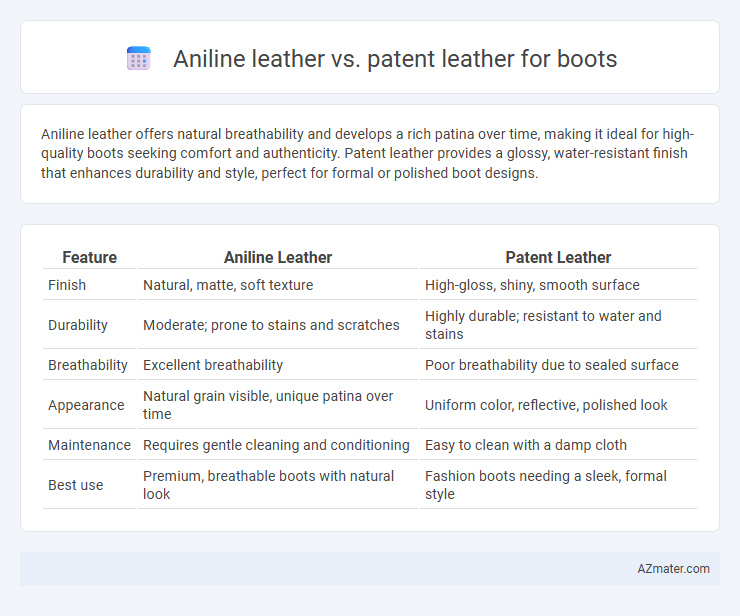Aniline leather offers natural breathability and develops a rich patina over time, making it ideal for high-quality boots seeking comfort and authenticity. Patent leather provides a glossy, water-resistant finish that enhances durability and style, perfect for formal or polished boot designs.
Table of Comparison
| Feature | Aniline Leather | Patent Leather |
|---|---|---|
| Finish | Natural, matte, soft texture | High-gloss, shiny, smooth surface |
| Durability | Moderate; prone to stains and scratches | Highly durable; resistant to water and stains |
| Breathability | Excellent breathability | Poor breathability due to sealed surface |
| Appearance | Natural grain visible, unique patina over time | Uniform color, reflective, polished look |
| Maintenance | Requires gentle cleaning and conditioning | Easy to clean with a damp cloth |
| Best use | Premium, breathable boots with natural look | Fashion boots needing a sleek, formal style |
Introduction to Aniline and Patent Leather Boots
Aniline leather boots are crafted from high-quality, full-grain leather dyed with soluble dyes that preserve the natural texture and breathability, offering a soft and luxurious feel. Patent leather boots feature a coated finish that creates a glossy, shiny surface, providing water resistance and easy maintenance while sacrificing some breathability. Both materials cater to different style preferences and functional needs, with aniline leather emphasizing natural beauty and patent leather prioritizing durability and shine.
Understanding Aniline Leather: Features and Benefits
Aniline leather, prized for its natural look and breathability, is dyed exclusively with soluble dyes that retain the hide's original texture and markings, offering a unique and luxurious aesthetic for boots. This type of leather is softer and more flexible than patent leather, allowing for greater comfort and a more personalized fit over time. Its porous surface enhances moisture absorption and breathability, making aniline leather boots ideal for those seeking durability combined with a natural appearance.
What Sets Patent Leather Apart?
Patent leather stands apart from aniline leather due to its high-gloss, mirror-like finish achieved through a coating of lacquer or synthetic resin. This coating not only enhances visual appeal but also provides superior water resistance and easier maintenance compared to the porous, natural surface of aniline leather. While aniline leather offers breathable softness and subtle texture variations, patent leather's durability and shine make it a distinctive choice for sleek, polished boots.
Appearance and Aesthetic Differences
Aniline leather boots showcase a natural, matte finish that highlights the hide's unique grain and subtle imperfections, providing a rich, authentic appearance favored for its organic texture. Patent leather boots boast a glossy, mirror-like sheen achieved through a high-gloss coating, delivering a sleek and polished aesthetic ideal for formal or fashion-forward styles. The soft, breathable nature of aniline leather contrasts with the stiff, water-resistant patent leather, influencing both the look and feel of the finished boot.
Comfort and Breathability in Boots
Aniline leather offers superior breathability and comfort due to its minimal finishing, allowing the natural grain to remain porous and flexible, which helps regulate foot temperature and moisture. Patent leather, coated with a glossy, impermeable finish, restricts airflow, often leading to reduced breathability and potential discomfort during extended wear. For boots prioritizing comfort and breathability, aniline leather is the more advantageous choice compared to the less ventilated patent leather.
Durability: Aniline vs. Patent Leather
Aniline leather offers moderate durability with excellent breathability and a natural look but is prone to scratches and staining, making it less ideal for rugged boot use. Patent leather provides superior durability due to its high-gloss, protective coating, which resists water, scuffs, and wear, enhancing boot longevity. For boots requiring tough, long-lasting material, patent leather outperforms aniline leather in maintaining appearance and structural integrity over time.
Maintenance and Care Requirements
Aniline leather boots demand regular conditioning with pH-balanced leather creams to prevent drying and maintain their natural finish, as their porous surface absorbs oils and moisture easily. Patent leather boots require less frequent conditioning but need gentle cleaning with a damp cloth and occasional application of patent leather polish to preserve their high-gloss appearance and prevent cracks. Both materials benefit from avoiding prolonged exposure to direct sunlight and moisture to extend boot lifespan and appearance quality.
Price Comparison: Cost Factors
Aniline leather boots typically cost more due to the use of high-quality, full-grain leather that requires minimal processing and preserves natural markings, enhancing durability and comfort. Patent leather boots are generally less expensive, as the leather undergoes a coating process that masks imperfections and simplifies production but offers less breathability and flexibility. Price differences also depend on brand reputation, craftsmanship, and the extent of finishing treatments applied to each leather type.
Ideal Uses and Style Recommendations
Aniline leather, known for its natural, breathable surface, is ideal for boots requiring a soft, luxurious feel and a rich, matte finish, making it perfect for casual or high-end fashion footwear. Patent leather offers a glossy, durable exterior ideal for formal boots or statement pieces that demand a polished, sleek appearance and easy maintenance. Choose aniline leather for versatile, everyday wear with a natural aesthetic, while patent leather suits occasions requiring sophistication and standout shine.
Conclusion: Choosing the Right Leather for Your Boots
Aniline leather offers a natural, breathable finish with a soft, supple texture ideal for those seeking comfort and a unique patina over time, while patent leather provides a sleek, glossy appearance with enhanced water resistance and easy maintenance suitable for formal or wet conditions. Selecting the right leather depends on your lifestyle and intended use: prioritize aniline leather for durability and natural aesthetics in casual or rugged environments, or choose patent leather for a polished look and low upkeep in dressier settings. Understanding the distinct qualities of aniline versus patent leather ensures your boots meet both functional needs and style preferences.

Infographic: Aniline leather vs Patent leather for Boot
 azmater.com
azmater.com